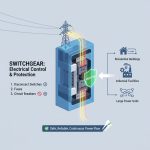The residential energy storage market stands at a pivotal moment in its evolution, representing one of the most dynamic sectors within the global energy transition. As homeowners increasingly seek energy independence and resilience against grid instabilities, the deployment of home battery storage systems has transformed from a niche luxury to an essential component of modern residential infrastructure. This shift reflects broader changes in how we generate, store, and consume electricity at the household level, driven by technological advancement, economic incentives, and environmental consciousness.
Current Landscape of the Residential Energy Storage Market
The residential energy storage sector has experienced remarkable growth, establishing itself as a cornerstone of the distributed energy revolution. This expansion reflects fundamental changes in consumer behavior, technological capabilities, and market economics that collectively reshape how households interact with the electrical grid.
- Global market valued at USD 2.68 billion in 2024, projected to reach USD 13.58 billion by 2035.
- Compound annual growth rate (CAGR) of 15.91% expected between 2025-2035.
- Europe dominated with 41.3% market share in 2024, driven by aggressive renewable policies and high electricity prices.
- North America emerged as the fastest-growing region with 57% year-over-year growth in residential installations.
- U.S. achieved record deployment of 1,250MW in residential storage during 2024.
- Key growth drivers include rising electricity costs, grid reliability concerns, and solar-plus-storage adoption.
Market Valuation and Forecast (2025–2035)
The global Residential Energy Storage Market reached a valuation of USD 2.68 billion in 2024, marking a significant milestone in the industry’s maturation. This figure represents the culmination of years of technological development, policy support, and growing consumer awareness about energy security and sustainability. The market’s current size reflects installations across millions of homes worldwide, with battery storage systems ranging from compact units serving basic backup needs to sophisticated whole-home solutions integrated with renewable generation.
Industry projections indicate the residential energy storage market will expand to USD 13.58 billion by 2035, representing a fivefold increase from current levels. This anticipated growth stems from multiple converging factors: declining battery costs, improved energy density, enhanced system lifespans, and accelerating adoption of distributed solar generation. The projected market expansion also accounts for emerging markets beginning to embrace residential storage solutions as grid infrastructure challenges persist and renewable energy deployment accelerates globally.
The compound annual growth rate of 15.91% between 2025 and 2035 underscores the market’s robust expansion trajectory. This growth rate significantly exceeds many other energy sector segments, highlighting residential storage as one of the fastest-growing components of the global energy infrastructure. The sustained double-digit growth reflects continuous technological improvements, expanding manufacturing capacity, and broadening geographic adoption beyond early-adopter markets.
Our comprehensive Residential Energy Storage Market report is ready with the latest trends, growth opportunities, and strategic analysis. View Sample Report PDF.
Europe dominated the residential energy storage market in 2024, capturing more than 41.3% of global revenue share. This leadership position results from aggressive renewable energy policies, high electricity prices, and strong consumer environmental consciousness across European nations. Countries like Germany, Italy, and the United Kingdom have implemented comprehensive support mechanisms combining feed-in tariffs, net metering policies, and direct storage incentives that catalyze market growth. European consumers also demonstrate higher willingness to invest in energy independence technologies, driven by energy security concerns and sustainability goals.
North America emerged as the fastest-growing regional market, with substantial expansion expected throughout the forecast period. The United States energy storage market achieved its first year of double-digit deployment in 2024, with total installations surpassing 12,314MW across all segments. Within this broader market, residential storage installations reached 1,250MW in 2024, representing a 57% increase over 2023 levels. This acceleration reflects growing grid reliability concerns, favorable policy environments in key states, and increasing solar-plus-storage adoption rates.
Using 2024 as the base year provides a comprehensive snapshot of the market following several transformative developments. The year marked significant milestones including record-breaking quarterly installations, expanded manufacturing capacity, and implementation of major policy initiatives supporting residential storage deployment. The residential segment specifically saw 380MW of new capacity installed in the fourth quarter alone, establishing new benchmarks for quarterly deployment.
Key Growth Drivers Shaping the U.S. Residential Sector
Multiple interconnected factors drive residential energy storage adoption across the United States. Rising electricity costs motivate homeowners to seek alternatives that provide both immediate savings and long-term price protection. Grid reliability concerns, exacerbated by extreme weather events and aging infrastructure, push consumers toward backup power solutions. The proliferation of rooftop solar installations creates natural synergies with battery storage, enabling homeowners to maximize self-consumption and achieve greater energy independence.
Federal tax incentives play a crucial role in market expansion. The Residential Clean Energy Credit allows homeowners to claim 30% of installation costs for renewable energy systems including battery storage, significantly improving project economics. State-level programs provide additional support, with New York allocating $100 million specifically for residential storage incentives. These policy mechanisms reduce upfront costs and accelerate payback periods, making storage accessible to broader consumer segments.
For Residential Energy Storage Market Research Report and updates detailed: View Full Report Now!
Evolving Market Dynamics and Trends in 2024-2035
The residential energy storage market operates within a complex ecosystem of technological innovation, policy evolution, and shifting consumer preferences. Understanding these dynamics provides insight into future market trajectories and emerging opportunities.
- Federal Residential Clean Energy Credit provides 30% tax credit through 2032, dramatically improving project economics.
- State programs like New York’s $100 million allocation create additional incentives ranging from $200-450/kWh.
- Time-of-use pricing and demand response programs transform batteries into revenue-generating assets.
- Consumer motivation shifted from environmental concerns to practical benefits including bill savings and backup power.
- Virtual power plant initiatives enable aggregated residential systems to provide grid services.
- Smart home integration accelerates adoption through AI-optimized energy management.
Influential Policy Changes and Incentives
Policy frameworks fundamentally shape market development through direct incentives, regulatory standards, and grid interconnection rules. The Inflation Reduction Act extended and expanded federal tax credits for residential clean energy investments, providing market certainty through 2032. These credits cover 30% of system costs for qualifying installations, dramatically improving project economics for homeowners.
State-level initiatives complement federal programs with targeted support mechanisms. New York’s comprehensive approach allocates substantial funding across residential and retail storage segments, with specific carve-outs for disadvantaged communities. The state’s program structure includes geographic differentiation, with incentive rates varying between $200-250/kWh for standard residential installations and $450/kWh for inclusive storage initiatives serving vulnerable populations.
California continues leading policy innovation through its Self-Generation Incentive Program and evolving net energy metering structures that increasingly favor storage adoption. Massachusetts, Connecticut, and other northeastern states have implemented similar programs recognizing storage’s grid benefits and resilience value. These state programs often stack with federal incentives, creating compelling economic propositions for homeowners.
Utility rate structures increasingly incentivize storage deployment through time-of-use pricing, demand charges, and participation opportunities in demand response programs. Virtual power plant initiatives allow aggregated residential storage systems to provide grid services, creating new revenue streams for homeowners while supporting grid stability. These evolving compensation mechanisms transform residential batteries from simple backup devices into active grid assets.
Consumer Adoption Trends and Awareness
Consumer attitudes toward residential energy storage have shifted dramatically as awareness grows about technology capabilities and benefits. Early adopters motivated primarily by environmental concerns have given way to mainstream consumers seeking practical benefits including bill savings, backup power, and energy independence. This evolution reflects improved system reliability, simplified installation processes, and compelling economic returns in many markets.
The integration of smart home technologies accelerates storage adoption by enabling sophisticated energy management capabilities. Modern storage systems incorporate artificial intelligence and machine learning algorithms that optimize charging and discharging patterns based on usage patterns, weather forecasts, and electricity pricing. These intelligent features maximize economic benefits while requiring minimal user intervention, appealing to convenience-oriented consumers.
Solar-plus-storage installations increasingly represent the default configuration for new residential solar deployments. Homeowners recognize that pairing generation with storage maximizes self-consumption, provides backup capabilities, and future-proofs investments against changing utility regulations. This bundled approach simplifies decision-making and often provides better financing terms than standalone storage installations.
Leading Residential Energy Storage Technologies
Technology selection fundamentally impacts system performance, longevity, and economics. The residential storage market has consolidated around two primary battery chemistries, each offering distinct advantages for specific applications.
- Lithium-ion technology dominated with 81.2% market share in 2024.
- Round-trip efficiency exceeds 90% for lithium-ion systems versus 70-80% for lead-acid.
- Lithium iron phosphate (LFP) chemistry gaining share due to enhanced safety and 10,000+ cycle life.
- Cell-level costs dropped below $200/kWh, approaching grid parity in many markets.
- Modular designs enable capacity expansion as needs evolve.
- Lead-acid systems declining due to lower energy density, shorter lifespan, and maintenance requirements.
Lithium-ion Solutions: Advancements and Benefits
Lithium-ion technology dominated the residential storage market with an 81.2% share in 2024, reflecting superior performance characteristics and continuous cost reductions. These systems offer high energy density, enabling compact installations suitable for space-constrained residential applications. Round-trip efficiency typically exceeds 90%, minimizing energy losses during charge-discharge cycles and maximizing economic returns.
Recent technological advances focus on improving safety, extending cycle life, and reducing costs. Lithium iron phosphate (LFP) chemistry has gained market share due to enhanced thermal stability and longer lifespan compared to traditional nickel-manganese-cobalt formulations. Manufacturing scale improvements and supply chain optimization have driven costs below $200/kWh at the cell level, approaching grid parity in many markets.
Modular designs allow homeowners to start with smaller systems and expand capacity as needs evolve or budgets permit. Advanced battery management systems optimize cell balancing and thermal management, extending system life beyond 10,000 cycles in many cases. Integrated inverters and simplified installation procedures reduce total system costs while improving reliability.
Lead-acid Systems: Applications and Drawbacks
Lead-acid batteries maintain a presence in the residential storage market, particularly for budget-conscious consumers and specific use cases. These systems offer lower upfront costs and proven reliability based on decades of deployment experience. Deep-cycle lead-acid batteries designed for renewable energy applications can provide adequate performance for basic backup power needs.
However, significant limitations constrain lead-acid adoption in modern residential applications. Lower energy density requires substantially more space for equivalent capacity compared to lithium-ion alternatives. Cycle life typically ranges from 500-1,500 cycles, necessitating more frequent replacements. Round-trip efficiency of 70-80% results in higher energy losses, reducing economic returns particularly in daily cycling applications.
Maintenance requirements including periodic watering and equalization charging add complexity for residential users. Environmental concerns regarding lead content and recycling requirements also influence consumer preferences toward cleaner technologies. These factors collectively explain lead-acid’s declining market share as lithium-ion costs continue falling.
Impact of Renewable Integration on Market Expansion
The symbiotic relationship between distributed renewable generation and residential storage fundamentally drives market expansion. This integration creates value propositions exceeding the sum of individual components.
- Solar-plus-storage systems enable 80%+ self-consumption rates versus 30-40% for solar-only.
- Seamless backup power during outages increasingly valued as extreme weather events multiply.
- DC-coupled architectures minimize conversion losses and reduce component counts.
- Time-of-use net metering creates stronger incentives for storage adoption.
- Grid connectivity enables participation in demand response and ancillary services.
- Non-export provisions simplify installations for backup-focused consumers.
Synergies between Solar Panels and Home Storage
Residential solar installations provide the primary use case for home battery deployment, with solar-plus-storage systems becoming the standard configuration in many markets. This pairing addresses solar generation’s fundamental limitation of producing power only during daylight hours, enabling true energy independence. Homeowners can store excess midday generation for evening consumption, dramatically reducing grid dependence and electricity bills.
Storage systems enable homeowners to maximize self-consumption rates, often exceeding 80% compared to 30-40% for solar-only installations. This improvement becomes particularly valuable as feed-in tariffs decline and utilities implement less favorable net metering policies. Time-shifting solar generation to peak demand periods provides additional economic benefits through avoided high-rate purchases.
Beyond economic benefits, solar-plus-storage combinations provide resilience against grid outages. Advanced inverter systems enable seamless transition to backup mode, maintaining power to critical loads during grid disruptions. This capability has become increasingly valuable as extreme weather events strain grid infrastructure. Some systems now offer whole-home backup capabilities, replacing traditional generator solutions with clean, quiet alternatives.
The technological integration between solar and storage components continues improving through standardized communication protocols and integrated system designs. DC-coupled architectures minimize conversion losses and reduce component counts, improving overall system efficiency and reliability. Smart inverters coordinate solar generation, battery charging, and grid interaction to optimize performance across varying conditions.
Role of Net Metering and Grid Connectivity
Net metering policies significantly influence storage adoption patterns by determining the economic value of grid-exported energy. Traditional full retail rate net metering reduces storage value propositions by allowing the grid to function as virtual storage. However, evolving policies increasingly differentiate between energy consumed and exported, creating stronger incentives for self-consumption through storage.
Time-of-use net metering structures assign different values to exported energy based on time periods, encouraging storage deployment to shift exports to high-value periods. Some jurisdictions implement instantaneous netting or buy-all-sell-all arrangements that further incentivize storage adoption. These policy evolutions reflect grid operators’ recognition that distributed storage provides system benefits beyond simple energy arbitrage.
Grid connectivity enables residential storage systems to participate in utility programs providing additional revenue streams. Demand response programs compensate homeowners for reducing consumption during peak periods, which storage facilitates without sacrificing comfort. Virtual power plant aggregations allow distributed storage resources to provide frequency regulation, voltage support, and other ancillary services traditionally supplied by large power plants.
Non-export provisions in some markets allow storage installation without complex interconnection agreements, simplifying deployment for homeowners primarily seeking backup power and self-consumption benefits. These arrangements reduce regulatory barriers while maintaining grid safety and reliability standards.
To learn more about the global trends impacting the future of Residential Energy Storage Market research report, Download a PDF Sample
Segmentation by Power Rating and System Size
Market segmentation by system capacity reveals distinct use cases and consumer preferences across different power ratings.
- 6kW to <10kW segment captured 52.5% market share, optimal for typical residential applications.
- Smaller 3kW to <6kW systems serve entry-level market with 8-15 kWh capacity.
- Systems provide critical load backup and time-of-use arbitrage capabilities.
- Larger 10kW to 29kW installations serve high-consumption households and small commercial applications.
- Modular expansion capabilities allow starting small and adding capacity over time.
- Professional installation and permitting processes well-established for mid-range systems.
Performance Analysis: 3kW to <6kW Systems
Smaller residential storage systems in the 3kW to <6kW range serve entry-level market segments and specific applications. These systems typically provide 8-15 kWh of usable capacity, sufficient for essential load backup and basic daily cycling applications. Installation simplicity and lower costs make these systems accessible to broader consumer segments, particularly in markets with moderate electricity prices or limited solar generation capacity.
Performance characteristics of smaller systems align well with typical residential load profiles in efficient homes. Critical load panels allow homeowners to maintain power to essential circuits during outages, covering refrigeration, lighting, and communication needs. Daily cycling applications focus on peak shaving and time-of-use arbitrage rather than complete grid independence.
Cost-effectiveness improves through standardized designs and streamlined installation procedures. Many systems in this range utilize wall-mounted configurations minimizing space requirements. Modular expansion capabilities allow homeowners to start small and add capacity as needs grow or budgets permit.
Demand Snapshot: 6kW to <10kW and 10kW to 29kW Segments
The 6kW to <10kW segment captured the largest market share at 52.5% in 2024, reflecting optimal sizing for typical residential applications. These mid-range systems provide 15-25 kWh of usable capacity, enabling substantial grid independence while maintaining reasonable costs. Power ratings support whole-home backup for moderately sized residences and complete daily cycling for average consumption patterns.
Systems in this range increasingly incorporate advanced features including generator integration, electric vehicle charging coordination, and smart load management. The balance between capability and cost attracts mainstream consumers seeking comprehensive energy solutions without over-sizing investments. Professional installation requirements and permitting processes are well-established for this segment, facilitating market growth.
Larger systems in the 10kW to 29kW range serve high-consumption households, small commercial applications, and consumers prioritizing complete energy independence. These installations often involve multiple battery units coordinated through sophisticated energy management systems. Use cases include large residences with electric heating/cooling, properties with electric vehicle fleets, and homes in areas with unreliable grid infrastructure.
Ownership Models in U.S. Residential Storage
Diverse ownership structures have emerged to address varying consumer preferences and financial capabilities, each offering distinct advantages and trade-offs.
- Customer ownership dominated with 60% market share, providing maximum control and ROI.
- Direct ownership typically achieves 5-10 year payback periods with incentives.
- Third-party models (leases/PPAs) eliminate upfront costs but reduce long-term economics.
- Utility-owned programs target low-income communities lacking capital access.
- Alternative ownership growing to address diverse consumer risk tolerances and financial capabilities.
- New York’s inclusive storage initiatives offer enhanced incentives for vulnerable populations.
Customer-owned Systems: Control and ROI
Customer ownership dominated the market in 2024, reflecting strong consumer preference for direct control over energy assets. This model provides maximum flexibility in system operation, maintenance decisions, and potential future modifications. Homeowners capture all economic benefits including bill savings, incentive payments, and potential grid services revenue.
Direct ownership typically delivers the strongest return on investment for consumers with available capital or financing access. Federal tax credits and state incentives improve project economics, often achieving payback periods of 5-10 years depending on local electricity rates and usage patterns. System ownership also increases property values, with studies indicating premiums of 3-4% for homes with solar-plus-storage systems.
Control advantages extend beyond economics to operational flexibility. Owners can optimize system operation for their specific priorities, whether maximizing bill savings, ensuring backup duration, or minimizing grid dependence. This control becomes particularly valuable as electricity rates and grid conditions evolve over system lifetimes exceeding 10-15 years.
Utility-owned and Third-party Models: Pros, Cons, and Growth
Alternative ownership models address capital constraints and complexity concerns that deter some consumers from direct ownership. Utility-owned programs allow energy providers to install and maintain storage systems on customer properties, typically in exchange for demand response participation rights. These programs provide grid benefits while offering customers backup power and potential bill savings without upfront investments.
Third-party ownership through leases or power purchase agreements (PPAs) has gained traction by eliminating upfront costs and transferring performance risks to specialized providers. These arrangements typically offer immediate bill savings with minimal customer responsibility for system operation or maintenance. However, long-term economics often favor direct ownership, and contract terms may limit operational flexibility.
Growth in alternative ownership models reflects market maturation and recognition that different consumers have varying risk tolerances and capital availability. Utility programs particularly target low-income communities and disadvantaged populations who might otherwise lack storage access. New York’s inclusive storage initiatives exemplify this approach, offering enhanced incentives for projects serving vulnerable populations.
Challenges with alternative ownership include complex contract terms, potential conflicts between owner and host interests, and uncertainty regarding long-term arrangements. Regulatory frameworks continue evolving to address these issues while protecting consumer interests and ensuring grid benefits materialize.
On-grid vs Off-grid Solutions: Comparative Overview
The distinction between grid-connected and off-grid storage systems reflects fundamental differences in design philosophy, capabilities, and economic considerations.
- On-grid systems represented 73.3% of installations, optimizing economic benefits through grid participation.
- Off-grid systems require 3-5x larger battery capacity for multi-day autonomy.
- Hybrid approaches balance grid participation benefits with extended island operation capability.
- Economic comparisons strongly favor on-grid systems in areas with reliable utility service.
- Regulatory frameworks primarily support grid-connected systems through interconnection standards.
- Off-grid systems avoid utility standby charges but miss significant financial incentives.
Operational Differences and Use Cases
On-grid storage systems represent the vast majority of residential installations, designed to operate in parallel with utility connections while providing backup capabilities during outages. These systems optimize economic benefits through daily cycling, time-of-use arbitrage, and demand charge reduction while maintaining grid support during normal operations. Advanced transfer switches enable seamless transitions between grid-connected and island modes, ensuring continuous power during disruptions.
Off-grid systems serve remote properties lacking utility connections or homeowners seeking complete energy independence. These installations require substantially larger battery capacity to ensure reliable power through extended periods of low renewable generation. System designs must account for worst-case scenarios including sequential cloudy days or seasonal variations in solar resources. Typical off-grid systems incorporate 3-7 days of autonomy, resulting in battery banks 3-5 times larger than equivalent on-grid installations.
Hybrid approaches blur traditional distinctions, with grid-connected systems designed for extended island operation becoming increasingly common. These designs balance the economic benefits of grid participation with resilience requirements, often incorporating generator backup for extreme scenarios.
Economic and Regulatory Implications in the U.S.
Economic comparisons strongly favor on-grid systems in areas with reliable utility service. The ability to use the grid as backup during extended low-generation periods eliminates the need for oversized battery capacity. Grid participation opportunities through net metering, demand response, and virtual power plants provide additional revenue streams unavailable to off-grid systems.
Regulatory frameworks primarily address grid-connected systems, with interconnection standards, safety requirements, and incentive programs designed for parallel operation. The New York Public Service Commission’s recent approval of retail and residential storage programs exemplifies comprehensive regulatory support for grid-connected storage. These programs require participation in utility demand response programs where available, ensuring grid benefits materialize.
Off-grid systems face fewer regulatory hurdles but miss significant financial incentives tied to grid participation. Insurance and financing can prove challenging for off-grid properties, as lenders and insurers prefer the reliability of utility backup. However, off-grid systems avoid utility standby charges and interconnection complexities that can delay grid-connected projects.
Regional Market Insights and Growth Hotspots
Geographic variations in market development reflect diverse policy environments, electricity rate structures, and grid reliability challenges across regions.
- California leads absolute deployment driven by high rates, favorable policies, and wildfire shutoffs.
- Texas emerged as major growth market with 1,185MW total storage installations in Q4 2024.
- Northeastern states show strong growth despite lower solar resources due to high electricity rates.
- Southeast and Southwest regions demonstrate highest growth potential combining favorable resources and resilience needs.
- Europe maintained market leadership with Germany and Italy leading deployment.
- Asia Pacific markets led by Australia show highest global adoption rates.
North America’s Market Leadership and State-wise Trends
North America’s residential storage market exhibits strong state-level variations driven by policy differences and local market conditions. California leads absolute deployment volumes, supported by high electricity rates, favorable policies, and frequent grid reliability challenges. The state’s evolving net metering rules increasingly favor storage adoption, while wildfire-related public safety power shutoffs create compelling resilience value propositions.
Texas emerged as a major growth market with 1,185MW of total storage installations in Q4 2024, driven by grid reliability concerns following recent winter storms and summer demand peaks. The state’s deregulated market structure enables innovative retail electricity plans incorporating residential storage, while the absence of state-level interconnection standards actually simplifies some deployment scenarios.
Northeastern states demonstrate strong growth trajectories despite lower solar resources, driven by high electricity rates and comprehensive policy support. Massachusetts, Connecticut, and New York have implemented coordinated approaches recognizing storage’s winter peak reduction benefits. New York’s allocation of $100 million specifically for residential storage incentives signals serious commitment to deployment acceleration.
Emerging markets include southeastern states recognizing storage’s hurricane resilience benefits and midwestern states with increasing renewable generation. State-level incentive programs in Maryland, Illinois, and Oregon complement federal support to improve project economics. Even traditionally lagging regions show increased interest as battery costs decline and extreme weather events highlight grid vulnerabilities.
Comparative Analysis: Europe, Asia Pacific, Latin America, Middle East & Africa
Europe’s market leadership stems from comprehensive policy frameworks, high consumer awareness, and strong renewable energy deployment. Germany remains the largest European market, with integrated solar-plus-storage systems becoming standard for new installations. Italy’s Superbonus incentive program dramatically accelerated deployment, while the UK market grows despite less favorable solar resources.
Asia Pacific markets show diverse development patterns, with Australia leading residential storage adoption rates globally. Japan’s focus on resilience following natural disasters drives steady growth, while emerging markets in Southeast Asia begin exploring storage to address grid reliability challenges. China dominates manufacturing capacity but shows limited domestic residential deployment due to low electricity rates and reliable urban grids.
Latin American markets remain nascent but show significant potential given widespread grid reliability issues and declining storage costs. Brazil and Mexico lead regional development, with off-grid and weak-grid applications driving initial adoption. Middle Eastern markets focus primarily on commercial and utility-scale applications, though residential interest grows in countries diversifying beyond fossil fuels.
African markets present unique opportunities for leapfrogging traditional grid infrastructure through distributed solar-plus-storage systems. Nigeria, Kenya, and South Africa show early adoption in urban areas with unreliable grid service. Pay-as-you-go business models adapted from mobile phone markets enable deployment despite capital constraints.
Scope of the Industry
- Market transformation from USD 2.68 billion to USD 13.58 billion reflects fundamental shift in residential energy.
- Lithium-ion dominance strengthening as costs decline and performance improves.
- Policy support remains crucial with most successful regions implementing comprehensive approaches.
- Virtual power plants and peer-to-peer trading will transform homeowners into active market participants.
- Success requires balancing standardization for cost reduction with customization for diverse use cases.
- Winners will simplify complexity while delivering reliable, economic solutions meeting real consumer needs.
The residential energy storage market stands poised for transformative growth through 2035, driven by technological advancement, supportive policies, and evolving consumer preferences. The convergence of declining costs, improved performance, and increasing grid challenges creates compelling value propositions across diverse global markets. As storage transitions from luxury to necessity, the market’s expansion from USD 2.68 billion to USD 13.58 billion reflects fundamental shifts in how households generate, store, and consume electricity.
Success in this evolving market requires understanding complex interactions between technology capabilities, policy frameworks, and consumer needs. Lithium-ion technology’s dominance will likely strengthen as continued innovation improves performance and reduces costs. Policy support remains crucial for market acceleration, with the most successful regions implementing comprehensive approaches addressing both economic and regulatory barriers.
The integration of storage with renewable generation, smart home technologies, and grid services creates value beyond simple backup power. As virtual power plants and peer-to-peer energy trading mature, residential storage systems will play increasingly important roles in future grid architecture. This evolution transforms homeowners from passive consumers to active participants in energy markets, democratizing access to previously utility-scale opportunities.
Market participants must navigate evolving regulatory landscapes, technology transitions, and changing consumer expectations. Success requires balancing standardization for cost reduction with customization for diverse use cases. As the market matures, winners will be those who simplify complexity while delivering reliable, economic solutions that meet real consumer needs.
Market Segmentation
Parameter
Details
Segment Covered
By Technology
- Lead-acid
- Lithium-ion (81.2%)
By Utility
- 3kW to <6kW
- 6kW to <10kW (52.5%)
- 10kW to 29kW
By Connectivity Type
- On-grid
- Off-grid
By Ownership Type
- Customer-owned
- Utility-owned
- Third-party Owned
By Operation Type
- Standalone Systems
- Solar and Storage System
By Region
- North America (U.S., Canada, Mexico)
- Europe (Germany, France, U.K., Italy, Spain, Nordic Countries, Benelux Union, Rest of Europe)
- Asia Pacific (China, Japan, India, New Zealand, Australia, South Korea, South-East Asia, Rest of Asia Pacific)
- Latin America (Brazil, Argentina, Rest of Latin America)
- Middle East & Africa
Companies Covered
- Tesla
- Panasonic Holdings Corporation
- BYD Company Ltd
- Enphase Energy
- Sonnen GmbH
- VARTA AG
- Delta Electronics
- Inc.
- Huawei Technologies Co.
- Ltd.
- Eaton
- SMA Solar Technology AG
- LG Energy Solution
- GoodWe
- E3/DC
- Alpha ESS Co.
- Ltd
- RCT-Power
- SOLARWATT
- SENEC
- Shanghai PYTES Energy Co.
- Ltd
- Pylon Technologies
- Co. Ltd
- Victron Energy
- Dyness
- TESVOLT AG
- Turbo Energy – Solar Innovation
- BST POWER (SHENZHEN) LIMITED
- WeCo srl
- Powervault
Customization Scope
Enjoy complimentary report customization—equivalent to up to 8 analyst working days—with your purchase. Customizations may include additions or modifications to country, regional, or segment-level data.
Pricing and purchase options
Access flexible purchase options tailored to your specific research requirements. Explore purchase options
Questions [FAQs.]:
What are the main challenges to scaling up residential energy storage in the U.S.?
The primary obstacles to widespread residential storage deployment include interconnection complexities, varying state regulations, and skilled installer shortages. Utilities often impose lengthy approval processes and technical requirements that delay projects and increase costs. Permitting procedures remain fragmented across jurisdictions, creating confusion and administrative burdens. Supply chain constraints periodically limit battery availability, while rapid technology evolution creates consumer hesitation about optimal timing for investments. Financing challenges persist for middle-income households who don’t qualify for low-income programs but lack capital for upfront purchases.
How are battery technology improvements affecting system affordability?
Continuous technological advancement drives dramatic cost reductions, with lithium-ion cell prices declining over 90% since 2010. Energy density improvements reduce physical footprints and installation costs, while extended cycle life enhances lifetime value propositions. Manufacturing scale and supply chain maturation further reduce costs, with residential system prices approaching $500-600/kWh installed in competitive markets. Advanced battery management systems and modular designs simplify installations and reduce labor costs. These improvements collectively enable payback periods under seven years in many markets with favorable electricity rates and incentive programs.
Which region in the U.S. is projected to see the fastest growth in residential installations?
The Southeast and Southwest regions show the highest growth potential, combining favorable solar resources, increasing extreme weather events, and improving policy environments. States like Florida, Arizona, and Nevada exhibit rapid adoption acceleration as consumers seek hurricane and heat wave resilience. Texas continues its explosive growth trajectory driven by grid reliability concerns and market-friendly regulations. Mountain states including Colorado and Utah emerge as growth markets with strong solar resources and increasing environmental consciousness among residents.
How Important Are Rare Earth Elements (REEs) to the Solar and Storage Industry?
While REEs play minimal roles in current lithium-ion battery chemistries, they remain crucial for permanent magnets in wind turbines and some motor applications. The shift toward lithium iron phosphate batteries actually reduces critical material dependencies, using abundant iron and phosphate instead of cobalt and nickel. Solar panels require minimal REEs, primarily in inverter components. The storage industry’s movement away from REE dependence improves supply chain security and reduces geopolitical risks, though lithium and graphite supplies remain important considerations.
What are the primary sources of energy that Canada is looking to store and manage more efficiently?
Canada focuses on storing renewable generation from its abundant hydroelectric resources, growing wind farms, and expanding solar installations. Provincial variations exist, with Ontario emphasizing nuclear and renewable integration, Alberta focusing on wind and solar to displace coal generation, and British Columbia leveraging storage to optimize its vast hydroelectric system. Distributed solar-plus-storage gains traction in urban areas seeking resilience and bill management. Northern communities explore storage to reduce diesel generator dependence and integrate renewable microgrids.
What’s going on in the area of battery technology that we need to know about?
Solid-state batteries promise revolutionary improvements in energy density and safety, though commercial deployment remains several years away. Silicon anode technology gradually enters commercial production, offering 20-40% capacity improvements. Advanced battery management systems incorporating artificial intelligence optimize performance and extend system life. Sodium-ion batteries emerge as potential lithium alternatives for stationary storage, offering cost advantages despite lower energy density. Recycling technology advances address end-of-life concerns and material recovery, supporting circular economy principles.
Where is the value in the commercial and industrial segment?
Commercial and industrial storage applications provide compelling value through demand charge reduction, often achieving 20-40% bill savings for high-demand customers. Time-of-use arbitrage and participation in utility demand response programs generate additional revenue streams. Reliability benefits prove crucial for sensitive operations including data centers, medical facilities, and manufacturing processes where outage costs exceed storage investments. The sector saw 145MW of installations in 2024, with 88% concentrated in California, Massachusetts, and New York where favorable rate structures and incentives align. Integration with on-site solar generation and electric vehicle charging infrastructure creates comprehensive energy management solutions for forward-thinking businesses.
![[Market Research Reports] – Research Google News Blog | VMR.Biz](https://www.vmr.biz/wp-content/uploads/2022/12/logo-removebg-preview.png)











